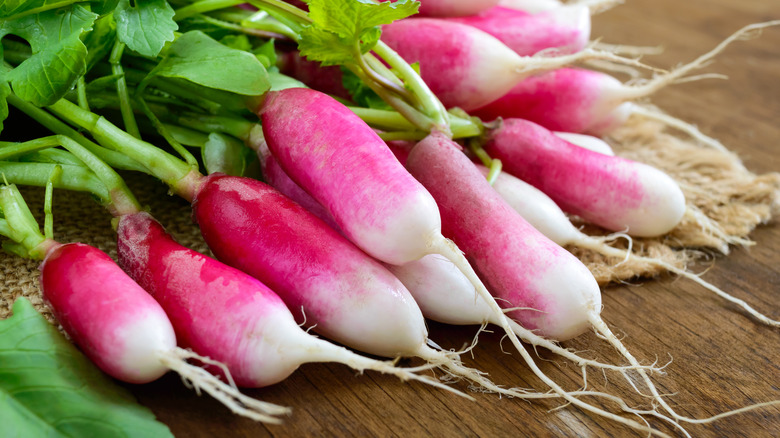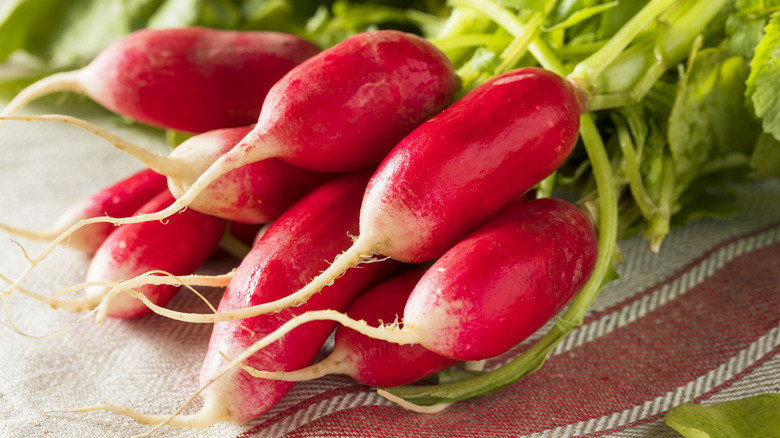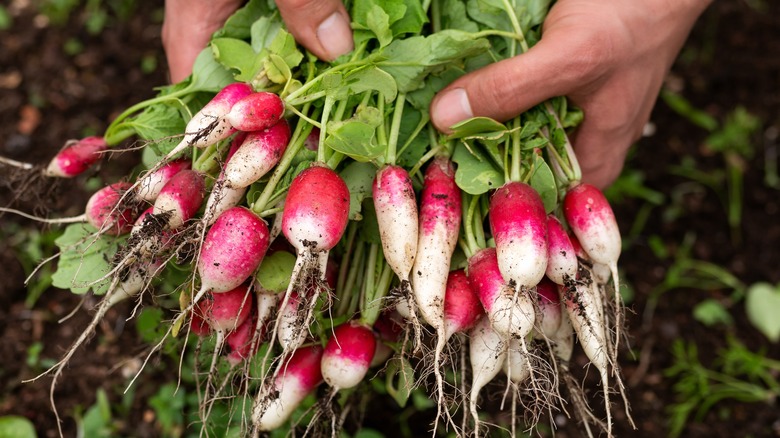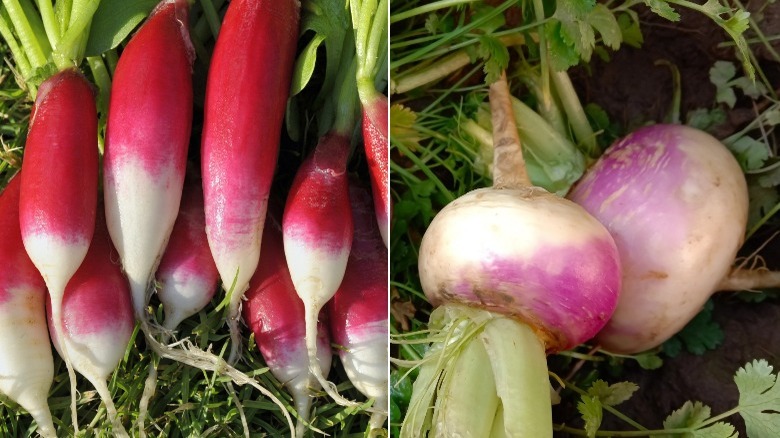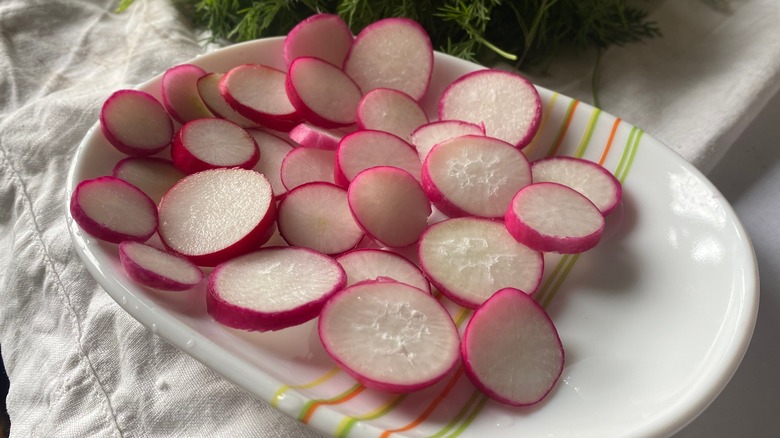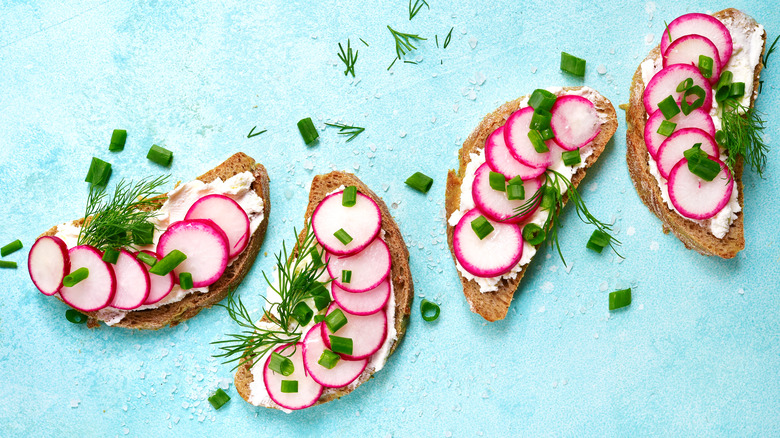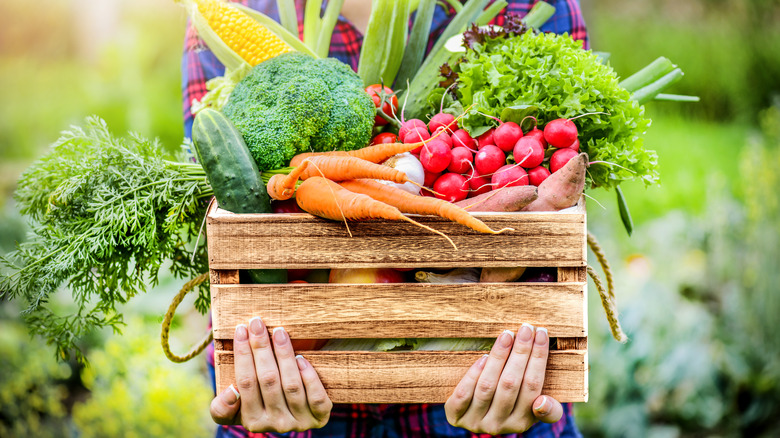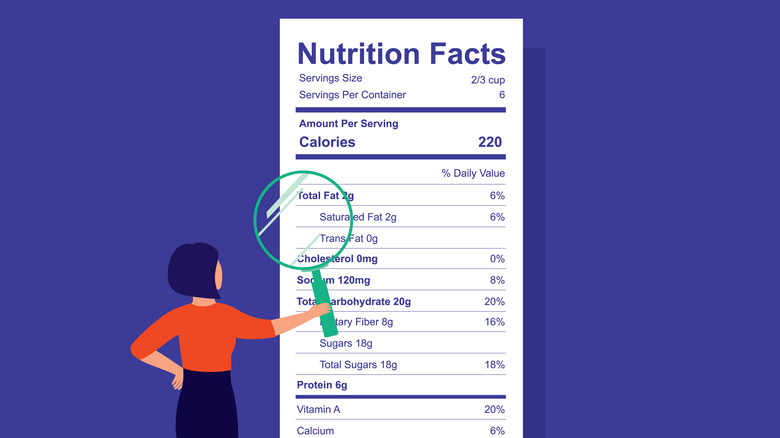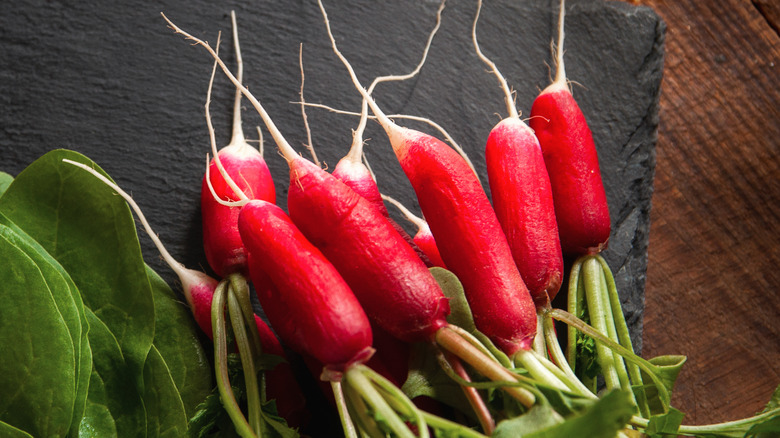What Are French Breakfast Radishes And What Makes Them Special?
Have you ever had a nice bowl of radishes and a cup of coffee for breakfast? Yeah, we haven't either. There is a general amount of confusion regarding the name for French Breakfast radishes (Raphanus sativus) because, according to The Washington Post, the French don't make a point of eating them for breakfast. Typically, the French start their day with either a baguette or croissant and a cup of gorgeous, dark coffee. So unless someone has baked up some kind of radish breakfast pastry — which sounds amazing — there is no room for the radish on the French breakfast table. Why, then, are they called Breakfast radishes?
The answer lies with the Victorian English. According to Specialty Produce, upper-class Victorians were apparently very fond of eating these mild little vegetables for breakfast at a specific radish festival. They added "French" to the name as an homage to the vegetable's country of origin. Just imagine Weatherby the Butler serving Lady Harpswell a plate of radishes with her morning tea. "Good lord, Weatherby! French Breakfast radishes again?"
"I'm afraid so, ma'am."
Of course, there is more to these colorful vegetables than some fictitiously humorous fodder over a bygone era. The French Breakfast radish is a versatile little root that is easy to grow and a delight to enjoy.
What are French Breakfast radishes?
French Breakfast radishes are members of the Brassicaceae family, a wide-ranging family of vegetables that includes Brussels sprouts, cabbage, rutabaga, turnip, broccoli, kale, and horseradish, per Britannica and Specialty Produce. French Breakfast radishes are just one of more than a hundred varieties of radish, including the Daikon long white and the cherry belle radish (via Healthline). Originating in France, these Breakfast radishes were first developed in 1879 and quickly became a favorite in Parisian markets (per Specialty Produce). They are known for their mild, crisp flavor and unique shape.
While we tend to think of radishes as the red exterior and white interior roots that we slice and put in salads, the French Breakfast radish has a look all its own. They are oblong rather than round or spherical, and they have edible green tops. The root, which is the most commonly eaten part of the vegetable, is two-toned, beginning as a beautiful pink at the top that steadily transitions into a milky white tip (via High Mowing Organic Seeds). These colors, along with the characteristic longer shape, are what make the French Breakfast radish instantly recognizable at market amidst a sea of competing vegetables.
How to grow French Breakfast radishes
The wonderful thing about vegetables is that you can grow almost any variety anywhere in the world. Of course, you need to take your hardiness zone into consideration before putting seeds in the ground. As evidenced by the USDA, you shouldn't be planting lemon trees if you live in Zone 2b in northern Maine. The French Breakfast radish, according to Baker Creek Heirloom Seeds, is a frost-hardy vegetable that is suitable for a decent range of hardiness zones, though they prefer temperatures between 50 and 75 degrees Fahrenheit. The radish takes three to six days to sprout after being planted into the earth. They should be sown about a ¼ inch deep and spaced 2 inches apart to allow enough space for the roots to take hold.
French Breakfasts are annuals, meaning that they grow for one season and then die off, as opposed to perennials, which, as Garden Heights explains, regrow every spring. According to Grow-Organic.com, you can plant these radishes at almost any time of year except for deep winter. Owing to their fast germination and sprouting, you can harvest and replant French Breakfast radishes multiple times per season. Harvest times can be anywhere between late spring and early winter.
Turnips vs French Breakfast radishes
A fair amount of conflation and confusion exists between radishes and turnips. According to Healthline, both turnips and French Breakfast radishes come from the same Brassicaceae family but are two different species. Turnips (Brassica rapa) share several similarities with their radish cousins, mainly in that they are both healthy, sharp root vegetables. However, strong differences exist between the two, mostly in the form of taste, appearance, and texture. We'll focus on the taste of the French Breakfast radish momentarily, but the general overall flavor of radishes is a peppery taste that turns ever spicier as they grow older. Most radishes don't exceed two to three centimeters in size, and they are most commonly red in color with a white interior. Radishes are commonly eaten raw in salads but can be cooked.
Turnips are much bigger, growing to be between two to three inches. While still rounded in shape and white inside, turnips have a different coloration than most radishes. Like the French Breakfast radish, a turnip can commonly come two-toned: purple near the top where it leaves out, transitioning to white on the bottom. Turnips tend to be milder in flavor than radishes, though when eaten raw, they can taste very similar. Turnips also tend to be on the sweeter side when young but grow steadily starchier as they age and are sometimes mashed and served like potatoes.
What do French Breakfast radishes taste like?
The taste of a French Breakfast radish can differ depending on what season it grew in. According to Garden Betty, radishes grown in spring and autumn tend to have a more mild flavor than ones grown in the summertime. This is owing to the fact that warmer soil leads to a spicier radish. Beneath the beautiful two-toned pink and white skin is an interior flesh that is dense and crisp. When raw, the French Breakfast radish has a flavor that is slightly sweet, but more on the earthy and peppery side. Cooked, the flavor transforms from peppery to nutty, with an undertone of mellow sweetness (via Specialty Produce).
The greens of the French Breakfast radish are also edible. British chef Fergus Henderson recommends tossing them in a vinaigrette as you would a normal salad, per The Washington Post. The radish greens tend towards the spicy side, a bit more like arugula than lettuce. They make an excellent swap in some of your favorite arugula-based dishes, like seared yellow-wax beans and arugula.
Enjoying French Breakfast radishes
You're not going to be making a full meal based around the French Breakfast radish as your star main ingredient. They're simply not substantial enough. However, these root vegetables are excellent for are as three things: snacks, incorporations, or side veggies. If you're aiming to eat these as a snack, there is probably no better way to enjoy them than how the French do. Radis beurre à tartiner — radish butter spread — is a great little snack of salted Breakfast radishes, blended with top-notch butter, and served atop a piece of toasted baguette (via The Washington Post and Laurent Mariotte).
There is no need to exclusively eat these radishes raw, however. There is a multitude of different ways in which French Breakfast radishes can be cooked. According to Specialty Produce, they can be chopped and incorporated into stir-fries or omelets, roasted and served as a side dish, baked into a casserole, or stirred into soups. The greens, as mentioned, can be tossed in a salad. The radish also pairs well with a variety of cheeses, such as blue cheese and feta, as well as a variety of different meat products, including beef, pork, and poultry.
Where to buy French Breakfast radishes
You can find radishes at virtually every supermarket in the nation. However, because the French Breakfast radish is an heirloom variety, you are more than likely not going to see it promoted in your supermarket's produce area. However, the stores they will most likely be stocked in will be the higher-end food stores that place a strong emphasis on fresh produce, like Whole Foods or a local food co-op. However, the easiest way to ensure that you have a decent supply of French Breakfast radishes is either to grow them yourself or to shop at your local farmers market.
Growing these oblong radishes is quite simple, as we explained earlier. Their seed-to-table time is around three weeks, according to High Mowing Organic Seeds. Seeds for French Breakfast radishes are very easy to come by as they are available from numerous sources, including the aforementioned High Mowing, as well as Baker Creek Heirloom Seeds, Growing Organic, Burpee Seeds, and Johnny's Selected Seeds.
Nutritional facts
Radishes are among some of the most nutritionally beneficial vegetables available for mass consumption. According to Healthline, radishes are excellent sources of folate for DNA synthesis, potassium for nerve transmission, as well as ample supplies of calcium and phosphorus. Radishes are also excellent sources of Vitamin C, which is an antioxidant that helps support your immune system. Other antioxidants common in radishes are tocopherols and carotenoids, which are excellent in promoting overall health functions.
In keeping with the radishes for breakfast theme we joked about earlier, The Washington Post explains that eating radishes for breakfast after a dairy-filled dinner or a day out working in the sun is extremely beneficial. The antioxidants found in radishes aid in eliminating wastes and toxins from the liver and gallbladder. Specialty Produce also states that French breakfast radishes are excellent sources of fiber for digestive health, can help reduce inflammation, and contain good levels of magnesium to help support nerve functioning.
The D'Avignon variety
While there are over 100 different varieties of radish, there are not many that are varietals of the French Breakfast radish, except one. Named for a commune in southeastern France, the D'Avignon radish is a longer, slightly milder version than the common French breakfast radish (via Deep Harvest Farm). Like the common Breakfast, the D'Avignon is an heirloom variety seed prized for its flavor and quick seed-to-plate time. While the common French Breakfast radish tends to be on the pinker side of red, the D'Avignon is a deeper red that still transitions to white down at the tip, per Burpee Seeds.
When looking at the growing instructions for D'Avignon radishes, there is again no real difference from the common Breakfast radish. The real differences between the two come in their sizes. D'Avignons are long and slender while the common Breakfasts are a little on the stouter and shorter side, though nowhere near as bulbous as other radishes. According to Johnny's Selected Seeds, D'Avignon radishes also have more white in their coloration and less of a canopy of greens. Overall, the two can be easily substituted for one another as sweet and peppery French radishes are perfect for a midday snack.
